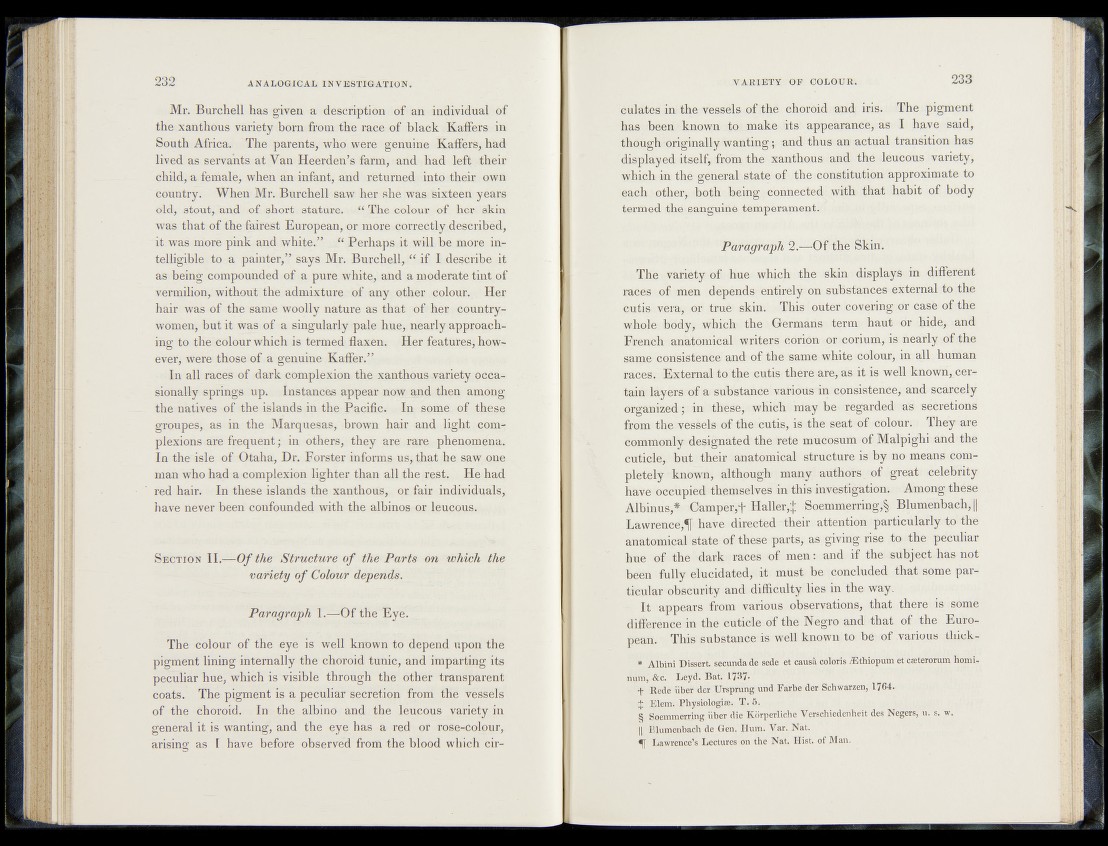
Mr. Burchell has given a description of an individual of
the xanthous variety born from the race of black Kaffers in
South Africa. The parents, who were genuine Kaffers, had
lived as servants at Van Heerden’s farm, and had lefl . their
child, a female, when an infant, and returned into their own
country. When Mr. Burchell saw her she was sixteen years
old; stout, and of short stature. f‘ The colour of. her skin
was that of the fairest European, or more correctly .described,
it was more pink and .white.:” Perhaps it will be more intelligible
to a painter,T says Mr. Burchell, “ if I describe it
as being compounded of a pure white, and a moderate tint of
vermilion, without the admixture vqf any other colour. Her
hair was of the same woolly nature as that of her fountry-
women, but it was of a singularly pale hue, , nearly approaching
to thScolour which is termed flaxen. Her feafpii^ however,
were those of a genuine Kaffer.”
In all races of dark complexion the xanthous-variety occasionally
springs up. Instances appear now and then- among
the natives of the islands in the Pacific. . In some, o ftb p se
groupes^as in the Marquesas, brown hair and dighk, com-;
plexions are frequent * in others, they are rare phenomena.
In the isle of Otaha, Dr. Forster informs us, that he saw one
man who had a complexion lighter than all the rest. He had
red hair. In these islands the xanthous, or fair individuals,
have never been confounded with the albinos or leucous.
S ection I I .— O f the Structure o f the Parts on which the
variety o f Colour depends.
Paragraph 1 .—O f the Eye.
The colour of the eye is well known to depend upon the
pigment lining internally the choroid tunic, and imparting its
peculiar hue, which is visible through the other transparent
coats. The pigment is a peculiar secretion from the vessels
of the choroid. In the,albino and the leucous variety in
general it is wanting, and the eye has a red or rose-colour,
arising as I have before observed from the blood which ciroulàtes
ini the vessëls-ofrthe, ehoroidfandf iriser The pigment
has been!? known 4dt'JB®-ke'lits’ appearance, as~ I have said,
though?origina]^kanting^ and thus an aetpal transition has
displayed itself^ (from thé xanthous^ and- the Jeuedus ^variety,
whieb in-the general? séatëVoF tjhe (constitution approximate ip
^àehoother, both- being ^ehnheefed?.,with) that habit of body
termed the sanguine temp er ameptjlfe
Paragraph 21—dl^tbe - Skin.
The variety of hue vÄich^ the skin display s in diffeféif
races of men dëpénds' entirelyjqnfsusKsIàlïd^^externaLto the
cutis, vera,> ©r! tnaè skin. This* l outerdcaveringeelt- caf*e- of the
whole, body,* whictó; the A (Jermârisf^^èmp haut or -.hidefi.and
French; anatomical writers -cdrion«or^corium, is nearlytoftthe
same conisistenbe'and^ofi.the same white ^colour* in all-.human
races. External to the cutis there -are,' alibis- welLdonowri^eem
tain layers of a substance various in consistemee*and scarcely
Organized ; in thesejHwhihh 'may be-regarded ta#'(Séèretions
from thefcvessels^ of the? cutis, is the -seatyèifi/colour:^ They are
commonly*designated the rete mucosum rofMalpighi andthe
cuticle^ - -but;* their anatomical structure islbymo means-com-
pleteiÿ'known, although many' authors of - great : * eeleb&ty
have-occupied- tbjgfiise'lives in this investigation.Among thèse
Albinus,%*;dampèr^t Haller^ Soemmerringf| Blumenbach,|
Lawrence^ have directèd - their - attentiotóiparticularly î to^ the
anatomical state of these parts, as giving-rise to - the peculiar-
hue of the dark races of men: and* if the^subjectihasnot
been fully elucidated,'-it must be-- concluded^ thati some particular
obscurity and difficulty lies in the way.
It appears from various observations, that, there; Is.- ; sonie
difference in the cuticle of the Nêgtorandi that of;the European.
This substance is well: known-to- be of .various thick -
* Albini Dissert, secundade sede et causà coloris ÆffiiopumWcæterorujm homi,
nùm,' &c. Leyd. Bat. 1737- ‘
d Rede übeif def .Ursprung und Farbe der Schwarzen, 1764.
.+ Elem. Physiologiæ. T. 5. ,
§ Soemmerring über die körperliche Verschiedenhèit’des Negers, u. s. w,
]| ."Blumenbach de Gen. Hum. Var. Nat.
Lawrence’s Lectures on the Nat. Hist, of Man.